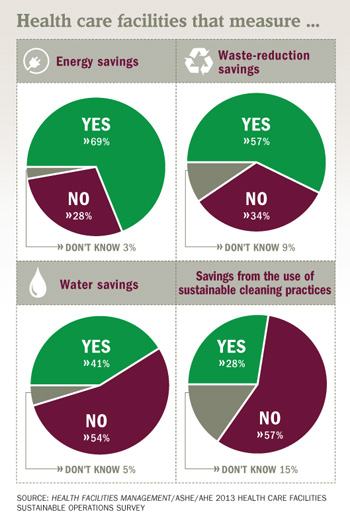Implementing a new cost-saving or efficiency-producing project is fine, but if you can't prove that it works, you're not likely to retain funding for it.
In our 2013 Sustainable Operations Survey, the top two sustainability-driven projects that health care facilities tend to measure include savings from energy- and waste-reduction. Sixty-nine percent of facilities said they measure energy savings and 57 percent measure waste-reduction savings. Forty-one percent said they measure spending on water while 28 percent measure savings from the use of sustainable cleaning practices.

|
Now that we are living in an era of benchmarking, it will be interesting to see if the number of health facilities that measure savings also will grow in these four categories. We are gathering data for the 2015 Health Facilities Management/American Society for Healthcare Engineering/Association for the Healthcare Environment Sustainable Operations Survey now and will release the results in our October issue.
Today's emphasis on benchmarking is spurred by a few different factors. Consolidation has led to some health systems having large, diverse facility portfolios, so eliminating as many variables as possible is a fiscally sound performance-management strategy. Also, as hospitals transition from fee-based to value-based care, all health care leaders — not just those in clinical roles — are being asked to help reduce hospital expenditures while improving quality of care.
Far from an admission of failure, benchmarking should be seen as an area of opportunity. Pointing out the outliers in a facility portfolio starts the discussion about how to bring those areas into alignment with the total system and perhaps reap some cost savings along the way. As a recent Health Facilities Management article points out, once you know what needs to be improved, sometimes even a small change can lead to big results.





